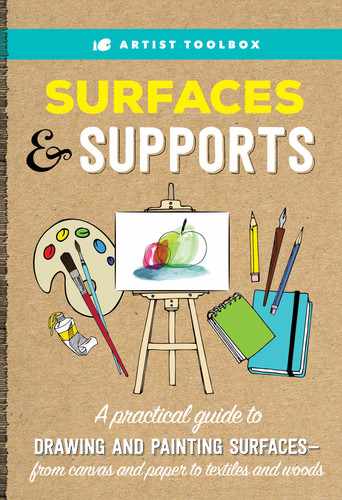CHAPTER 3:
Panels
Wood panels have been used for painting for centuries. While canvas offers more portability, wood panels are still widely used today, along with wood-based composite panels. When prepared properly, panels offer artists a firm, sturdy, and durable support for oil, acrylic, tempera, and encaustic painting.

COMMON HARDWOODS USED FOR PANELS
The best wood to use for panel painting is a hardwood that is not especially vulnerable to rotting or warping. Some of the most common woods used for art panels today are listed below.
|
TREE NAME |
ORIGIN |
QUALITIES |
|
Mahogany |
Semi-evergreen native to the American tropics (some African varietals are sourced for art panels as well) |
Reddish-brown, hard, and resistant to rot and insects |
|
Birch |
Broadleaf tree native to North America |
Pale in color, lightweight, and affordable |
|
Maple |
Broadleaf tree native to the Northern Hemisphere |
Light in color, hard, and affordable |
|
Basswood |
Broadleaf tree native to North America |
Creamy in color, smooth, lightweight, and affordable |
A BRIEF HISTORY OF WOOD PANEL PAINTING
Wood panels have a long history in Western art. From the fifth century BC through the Middle Ages, locally sourced wood served as a primary painting surface for artists. For example, Leonardo da Vinci—who lived in both Italy and France—worked on poplar, walnut, and oak hardwoods. To prepare the wood for painting, panels were usually treated with steam to remove sticky resins and dried to remove moisture. Then they were coated with sizing, gesso, paint, and finally varnish.
Wood was also the material of choice for Russian and Eastern European religious icon paintings, which are generally dated between the twelfth and nineteenth centuries. Artists applied animal glue over slabs of wood (such as linden or spruce), followed by a layer of linen, gesso, egg tempera paint, and sometimes gold leafing. Many icons have wooden slats inserted across the top and bottom to minimize warping. Still, over time, many have become slightly convex due to the expansion of wood beneath the paint.
Some of the world’s oldest and most famous paintings are on panel, from ancient altarpieces to da Vinci’s Mona Lisa and Jan van Eyck’s Arnolfini Portrait. Museums care for these works by maintaining consistent levels of humidity. Overall, wood has proven to be an effective and long-lasting painting support, and it remains a popular choice for painters today.

Pictured is an eighteenth-century Christian Orthodox icon believed to be from Lithuania. The thick panel features two wooden slats embedded in the panel to minimize the effects of warping over time. Also visible is a layer of linen fixed over the wood panel, which helped smooth out any defects in the wood.

PREPARED PANELS
In recent years, manufacturers have started offering a variety of prepared hardboards for specific media—no sanding or priming required. Take a look at some of the surfaces available.

This hardboard (9 mm thick MDF) is primed with acrylic “gesso” and is suitable for acrylic and oil. Its toothy surface simulates canvas texture to give you control over your strokes.

Pastelbord™ is MDF (medium-density fiberboard) primed with kaolin clay ground and textured with fine marble dust granules. This rough, toothy surface is ideal for pastel drawing but can also work with a variety of dry and wet media, from graphite and charcoal to acrylics, oils, and even watercolor. This board is available in white and a small array of midtones.

This gessoed hardboard is an HDF (high-density fiberboard) panel that is 1/8” thick and coated with gesso. The surface is compatible with all paints, most notably acrylic and oil. This board is available in white, midtone gray, and umber.

Watercolor panels feature a surface designed to accept wet washes, such as those of watercolor, gouache, and ink. Some textures mimic that of cold-pressed watercolor paper; others have a linen finish coated with gesso that is formulated for water-based media. They come in thin hardboard panels or thicker slabs cradled for depth and extra stability. These boards are generally more expensive than sheets of watercolor paper, but they don’t warp, and they make it easy to display finished work.




